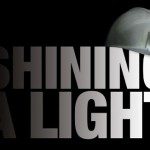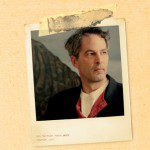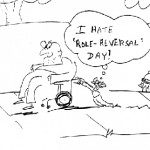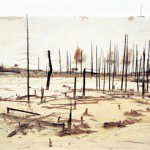Snapshots of Reality
What I gained as an immersion journalist in Iran
At a smoke-filled bar in the Gulf city-state of Dubai, the Filipino cover band rocks out to Guns N’ Roses as Canadian sailors on leave from patrolling the Gulf of Oman decorate their table with empty long-necked Budweisers. One of the more gregarious sailors is describing the lessons he’s learned since arriving in the Middle East. “They tell you this region is full of chaos, full of violence,” he says. “Then you get here and it’s nothing like what they say.” We are sitting near the speakers and he has to shout over the band. “The people here are even more beautiful than the landscape.” He surmises on the discrepancy between portrayal and reality. “It’s the Americanization of the media. Fox News. In Canada we like to think we welcome all perspectives, but our media is becoming Americanized too.”
While sailors stationed in the Middle East may not be the best judges of the media – they are “end users,” like most people who partake of the news – it’s safe to say that the current emphasis on dramatic divides, war-on-terror rhetoric and “shock and awe” coverage leaves much to be desired. Yet journalists today struggle within the constraints of a 24/7 system that has, in many cases, already outlined “the story” for them, often leaving little recourse but to furnish an update or source a few quotes. For this reason, long-form journalism – narrative nonfiction, literary journalism, New Journalism, whatever term you prefer – offers a powerful counterpoint.
I like the term immersion journalism, which describes the kind of up-close, experiential work that has captivated me throughout my career. This work has required me to spend many months – even years – in the places I’ve covered, to learn the local languages to varying degrees of proficiency, and to conclude that the answers to the rifts segmenting our world are not to be found in press conferences or by quoting mediatrained officials alone. They are, as often as not, found among ordinary people who are living “the news” yet rarely have a voice in it.
There is no substitute for immersive experience, nor for taking the time to explore and understand the underlying issues. Our current media environment, with its insistence on merciless deadlines and its addiction to what sociologists call a media frame (which can be defined as preconceived notions of a story), mitigates against the best that journalism can offer. For all great journalism must grapple with reality as it is, and attempt to convey that.
As an independent journalist, I have had the luxury – it is a luxury – of avoiding some of the pitfalls faced by many foreign correspondents. The first is the five-star hotel, where the only customers are well-heeled professionals and other journalists – all essentially insulated from the realities they seek to cover. The second is “parachute journalism” (a cousin to “hotel journalism”), which has correspondents fly in to sort out a story in a few days, a couple of weeks at best, thus compelling them to rely less on direct knowledge than on what they’ve read in the newspapers back home by someone in the very same predicament.
During the six months I spent in Iran covering, among other things, the Iranian view of the nuclear issue and the election of a new president, I spent only three days in a hotel worthy of the name. Iranians are sin-gularly hospitable, and rarely did a day pass that I was not invited to one home or another, and usually encouraged to stay for extended periods. Whether sitting on the floor of a peasant’s stone hut drinking dugh (a sour yogurt drink), or enjoying a glass of tea in the goat-hair tent of a nomad, or drinking ouzo (mixed with dugh of course) with Kurdish fighters, the peshmerga, around a campfire in the trenches of a battlefield from the Iran-Iraq war, or sitting at the dining tables of Tehran’s elites, I was exposed to the contradictions, the panoply of opinions that make up modern Iran. Peeling back the layers, I found my preconceived notions challenged at every juncture. I suffered in the heat beneath the obligatory headscarf; shared water pipes with strangers; hitchhiked through mountain passes on the back of smugglers’ trucks; was arrested on the border with Iraq; and translated heavy-metal lyrics for university students who took me along to their classes. I could not have written a simplistic report if I’d wanted to.
The task of narrative journalism is to act as a camera lens, to capture snapshots of reality and sort out the meaning on the road to a rough sort of truth. As the late Polish literary journalist, Ryszard Kapuscinski, who chronicled Africa for 40 years, said of his writing, “I managed to stop for a fraction of a second this eternally fleeting life and show the image to others.” And through these images, these frozen moments, a view may emerge of places, of peoples, who are far more complex than we have been led to believe, far less easy to categorize, driven by hopes, fears and desires akin to our own. There may be, embedded in these images, hints at how we might resolve the grave conflicts threatening our world.
The other day, at a cafe in Dubai where I often go to write, the table next to me was occupied by two young women in conservative black abayas talking animatedly to a young man with a shaved head and a pierced eyebrow. And because I’m a practiced eavesdropper, I knew that the young women were locals from this tiny kingdom in the heart of the region’s war zones – 1,000 kilometres from Iraq, a mere 150 from Iran – and that the young man was an American Jew. And because such scenes don’t make the evening news, I will tell you what they were saying.
Among other things they discussed sex, celebrities, and whether they would marry someone “really hot” (they were university-aged after all). They discussed the foreign influence in the region: he thought Dubai was mimicking the United States at a time when the U.S. is losing traction globally; they just liked meeting people from other countries, since the Emirate is home to more than 180 nationalities. He explained why ultra-Orthodox Jews grow long forelocks. They explained the differences between Shi’a and Sunni Islam.
In lightly accented English, one of the women said, “If only everyone would sit and talk like this, people would understand one other.”
Until then, there is journalism.














